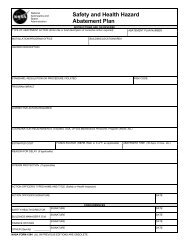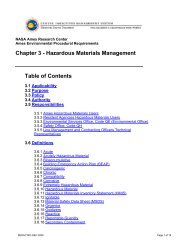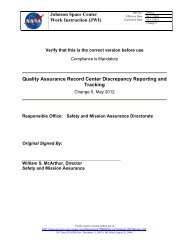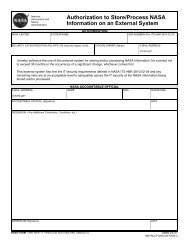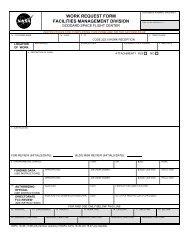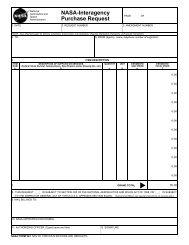JPR 8550.1 - Nasa
JPR 8550.1 - Nasa
JPR 8550.1 - Nasa
Create successful ePaper yourself
Turn your PDF publications into a flip-book with our unique Google optimized e-Paper software.
JSC Environmental Compliance<br />
Procedural Requirements<br />
<strong>JPR</strong> No.<br />
<strong>8550.1</strong>A XXXX.X<br />
Effective Date:<br />
Johnson Space Center • Environmental Compliance Program<br />
Expiration Date:<br />
Expiration Date:<br />
Page Number<br />
3/25/2011<br />
3/25/2016<br />
[Leave Blank]<br />
Page 17 of 123<br />
Chapter 2.0 Environmental Planning<br />
2.1 Scope<br />
This chapter describes the requirements and activities necessary for implementing and<br />
documenting compliant and effective environmental planning. It applies to new and revised<br />
programs, projects, processes and activities at JSC, EF, SCTF or EPFOL that have the<br />
potential to affect the environment including replacement or modification (such as the<br />
installation of a new piece of equipment).<br />
2.2 Background<br />
a. Environmental considerations shall be included in the planning and implementation of JSC<br />
activities and projects throughout their lifecycles.<br />
b. The goal is to identify and minimize the negative environmental impacts of the activity or<br />
project and to take all reasonable and appropriate steps to maximize environmentally<br />
beneficial decisions. This involves the thoughtful consideration of life cycle-ensuring that the<br />
environmental impacts are considered in the pre-planning, planning, design,<br />
construction/installation, operation, demolition, and decommissioning phases or any changes<br />
in scope of any task or project.<br />
2.2.1.1 Pre-planning, Planning, and Design Phase<br />
During the conceptual phase, decision-makers have the greatest opportunity to affect<br />
environmental impact, both to reduce the negative and enhance the benefits, than at any other<br />
time in the process. Elements related to this requirement may include life cycle cost evaluation<br />
and incorporating sustainable or conservation choices. Considering options that reduce<br />
environmental impacts during maintenance and on-going operations can reduce the annual<br />
operating costs of the equipment or facility. In addition, demolition and decommissioning can<br />
have significant environmental impacts during the removal and disposal of equipment and<br />
facilities. Examples of these considerations would include eliminating the use of toxic or<br />
hazardous materials (asbestos, polychlorinated biphenyls, lead or chromate paint, etc.),<br />
ensuring specified products contain primarily recyclable or reusable components, that systems<br />
are designed to be modular so that upgrades or changes can be made on part of a system and<br />
does not require disposal of the entire system, and ensuring systems are easily maintained or<br />
contained so that no contamination of soil or the surrounding facility occurs (clean up and<br />
disposal of contaminated materials is very expensive, can involve numerous regulatory<br />
requirements and can be time consuming during decommissioning) .<br />
2.2.1.2 Managing Environmental Impacts in the Implementation and Operation Phase<br />
a. All environmental requirements shall be met throughout the life of the operation, activity,<br />
process, or use of equipment.<br />
b. Once a planned program, project, activity, or process is implemented, then the responsible<br />
organization shall follow JSC EMS requirements for identifying, ranking, and documenting<br />
Verify correct version before use at<br />
http://server-mpo.arc.nasa.gov/Services/CDMSDocs/Centers/JSC/Home.tml.<br />
JSC Form JF2420B (MS Word August 28, 2006) (Revised May 30, 2007)



